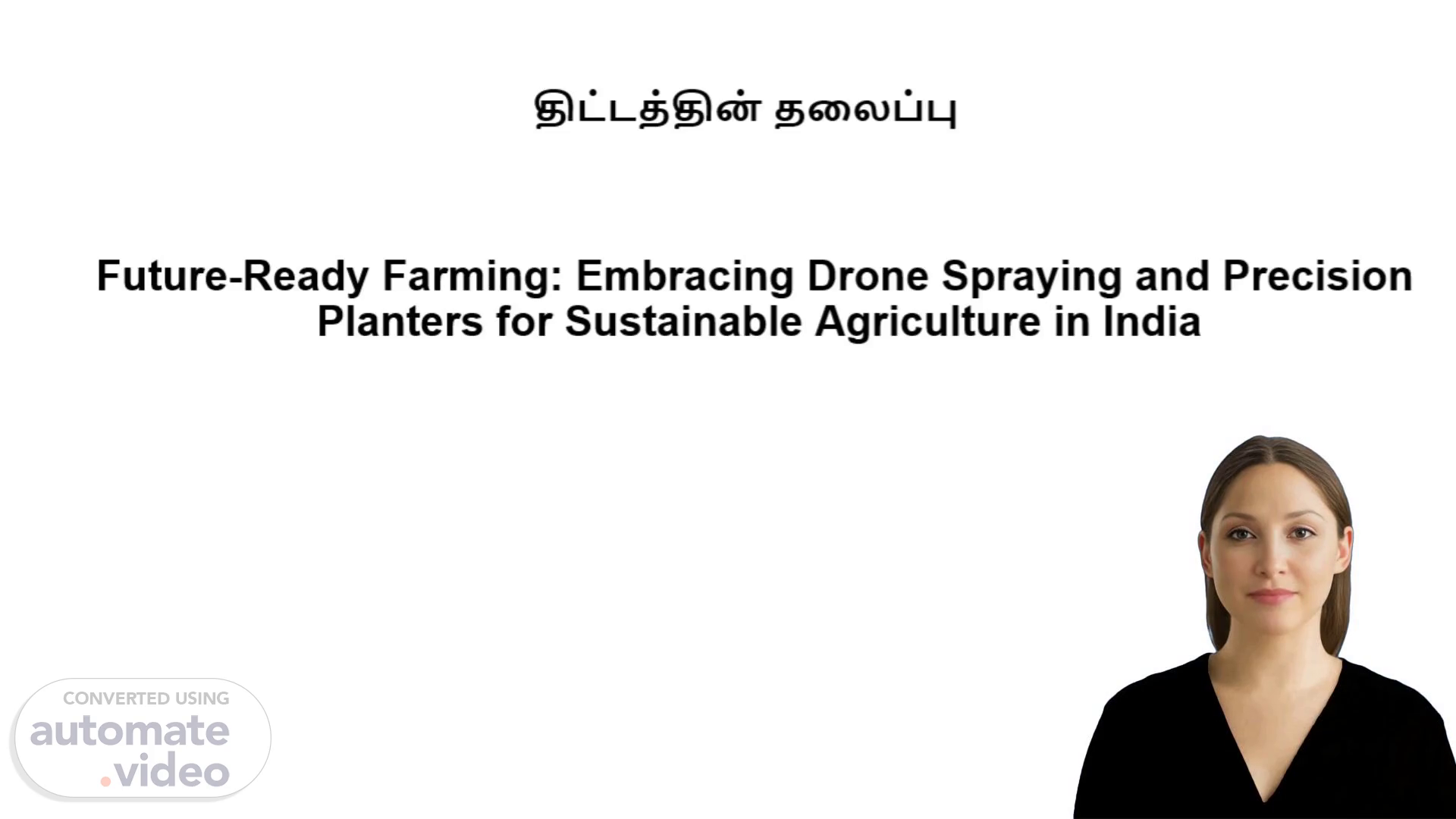
Page 1 (0s)
[Virtual Presenter] Good morning everyone. Today we will be discussing the value and the potential of drone spraying and precision planters for sustainable agriculture in India. We will cover the impact of these technologies and the ways in which they can help farmers in India maximize crop yields, enhance resource efficiency, and promote sustainable farming practices. Let's get started..
Page 2 (25s)
[Audio] Exploring the incredible potential of precision planters for sustainable agriculture in India, these planters offer numerous advantages, such as improved seed placement, reduced resource wastage, improved soil health, customizable planting strategies, and technological empowerment. These advantages could bring about drastic improvements to both the productivity and sustainability of India’s farming industry..
Page 3 (53s)
[Audio] Precision planters provide farmers the ability to cut down on input costs, grow various types of crops and maximize labor utilization. Additionally, precision planters are also in line with sustainable farming practices. We will now delve deeper into their components and usage..
Page 4 (1m 13s)
[Audio] Discussing the importance of Future-Ready Farming to enhance agricultural practices in India, I will focus on the use of drone spraying and precision planters. Drone spraying allows for precise application of seed, fertilizer, and water, helping to maximize crop yields and reduce input costs. Precision planters ensure uniform seed placement and optimal plant spacing, leading to improved crop quality and resource efficiency. Sustainable farming practices are encouraged, including those that promote soil health and lower the carbon footprint of farming. Farmers can benefit from increased economic viability by reducing labor requirements and input costs. Precision agriculture tools can be used to create resilient farming systems that are better able to adapt to and mitigate changing climate conditions..
Page 5 (2m 9s)
[Audio] Discussing the benefits of using precision planters and drones in sustainable agriculture in India is on the agenda. Aligning current agricultural practices with the needs of the future is the aim. We will analyze methods to raise awareness of these technologies and how to make them more affordable for farmers. Also, we will ponder how to provide training for farmers so they are able to use these tools correctly. Through exploring these options, sustainable agriculture in India can be prepared for the future..
Page 6 (2m 44s)
[Audio] In order to make agriculture in India more sustainable, the use of precision planting and drone spraying should be recognized. Such techniques can benefit farmers of varying sizes and backgrounds by improving their crop yields and quality, while also cutting labor costs. Additionally, drones can be used for the efficient spraying of fertilizers and pesticides, saving resources and making farms safer and more ecological. It is therefore imperative to embrace these technologies in order to make Indian agriculture future-proof..
Page 7 (3m 21s)
[Audio] As we move ahead with the development of a future-proof agricultural system in India, it is important to take into account the possible ramifications that this might have on those involved in the sector. This includes female farmers, agricultural laborers, and agribusinesses, all of whom could be impacted by the deployment of advanced precision planting and drone spraying technologies. Women farmers will have the advantage of having less strenuous labor due to the introduction of precision planters, while agricultural entrepreneurs and agribusinesses could find new profit-making avenues in the sale, leasing, and servicing of agricultural machinery. To ensure that everyone reaps the benefits of a more sustainable agricultural framework, it is vital to consider the effects that such technological advances may have on the individuals who rely on this system for their income..
Page 8 (4m 15s)
[Audio] A financial overview in this slide shows the five stages of future-ready farming, indicating it to be an economically viable investment. It is shown that Stage 5 has a total expenditure of 5.0 Crore, providing a positive return on investment. Stages 1-4 have a total expenditure of only 1.0 Crore each, which is a significant saving when implementing future-ready farming techniques..
Page 9 (4m 43s)
[Audio] We can see that the budget allocation for the 5 stages of Future-Ready Farming in India is as follows: Awareness and Outreach - 0.15 Rs per stage; Subsidy and Financial Support - 0.75 Rs per stage; Training and Capacity Building - 0.10 Rs per stage; Implementation (first stage) - 0.15 Rs per stage; Implementation (second stage) - 0.75 Rs per stage. The total budget allotment for these 5 stages is 1.00Rs..
Page 10 (5m 20s)
[Audio] Sustainable agriculture in India is set to benefit from the implementation of modern farming technologies, like drone spraying and precision planters. These innovations in vegetable farming bring about a number of advantages, including a remarkable improvement in vegetable production, more productive use of fertilizer and pesticide, and economic benefits for farmers via decreased input costs and improved yields. Farmers in India have the chance to reap the benefits of this important technology, benefits that would have been unimaginable before..
Page 11 (5m 56s)
[Audio] Technology, such as drone spraying and precision planters, is revolutionizing farming in India. These modern practices can save time, money, and resources while also boosting environmental sustainability. Consequently, they can result in improved crop health and reduced disease incidence, leading to increased yields. We appreciate you taking the time to learn more about this exciting development..